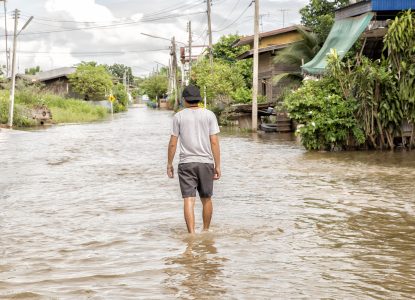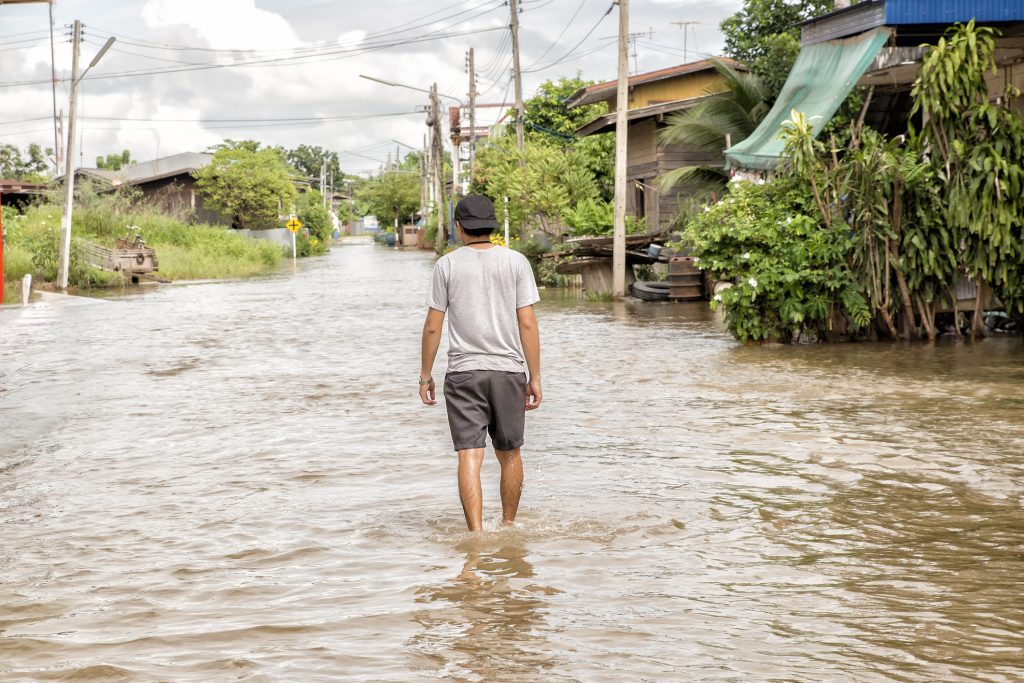By Sherrie Steiner, Historian, G20 Interfaith Forum
– – –
A Growing Crisis
As climate change makes some parts of the earth uninhabitable, a climate migration crisis looms that international law is not prepared to address (Bergeron 2023).
The field of migration and refugee law is largely dependent on national avenues for adjudication (IJRC n.d.). Since the 1990’s, the ‘human rights turn’ in migration and refugee law has pressured many national courts to adjust their transnational migration control policies to uphold international obligations in accordance with the principle of non-refoulement – not forcing refugees or asylum seekers to return to a country in which they are liable to be subject to persecution – but this progress is inadequate to meet future conditions (Kupferberg 2021).
Under current international refugee law, climate-displaced persons do not qualify for refugee status. They simply don’t fit the definition for who qualifies for international protection as established by the 1951 UN Convention Relating to the Status of Refugees and its 1967 Protocol Relating to the Status of Refugees (Poole 2021; Taha 2022).
According to international law, a refugee is:
Someone who is unable or unwilling to return to their country of origin owing to a well-founded fear of being persecuted for reasons of race, religion, nationality, membership of a particular social group, or political opinion. (UNHCR 1967[1951])
As far back as 2008, UNHCR Chief António Guterres was warning that climate change would become the biggest driver of population displacements, both inside and across national borders (Fleming 2009). According to UNHCR, an annual average of approximately 22 million people have been displaced following extreme weather conditions globally since 2008 (UNHCR n.d.). This is problematic for international governance (Rosignoli 2023). The UN International Organization for Migration estimates a forecast of 200 million people will migrate due to climate displacement by 2050 (Gaynor 2020). More recent figures now project that roughly 12% of Earth’s population (as many as 630 million people) may be displaced (Silk 2021). The anticipated increases in levels of migration related to climate change will surely strain existing systems for asylum (Poole 2021).
Moral Implications of Causation and Responsibility
The relationship between rising sea levels and climate change has moral implications (Silk 2021). The people most affected by rising waters reside in countries least responsible for production of carbon emissions (Guterres 2023). If a nation that emits high levels of carbon which raises sea levels that cause people from low carbon countries to be displaced from their homes, do the high-level carbon countries owe climate refugees aid?
Continuation of policies that disregard migrants have ethical as well as governance implications (Byravan and Rajan 2011). By 2100, some estimates predict sea-level rise will swallow 48 low-carbon producing countries, mostly island nations (Deshmukh 2019). Under current international law, these people have nowhere to go (Lustgarten 2020). A morally just evaluation of the situation requires taking causality between climate change and migration into consideration (Nawrotzki 2014). From this perspective, industrialized countries have a moral responsibility to compensate for harms that their actions have caused (Plumer, Friedman, Bearak and Gross 2022; Sommer 2021).
A New Global Precedent in Human Rights
The human rights turn in migration and refugee law is moving in the direction of recognizing climate refugees (Yoshida and Setzer 2020). When a man from the Pacific nation of Kiribati was denied asylum as a climate refugee by New Zealand’s Immigration and Protection Tribunal, the Court of Appeal and the Supreme Court, he was subsequently deported. He then took his case to the UN Human Rights Committee (UN HRC) on the grounds that New Zealand violated his right to life under the International Covenant on Civil and Political Rights by deporting him back to Kiribati.
The UN HRC set a global precedent when they ruled on his case, saying that a state will be in breach of its human rights obligations if it returns someone to a country where – due to the climate crisis – their life is at risk, or in danger of cruel, inhuman or degrading treatment (Sinclair-Blakemore 2020). The decision set the precedent for arguing that without robust national and international efforts, the effects of climate change in receiving states may expose individuals to violation of climate refugee’s rights under articles 6 or 7 of the Covenant and thereby trigger the non-refoulement obligations of sending states (Aleksandrova, Schraven and Serraglio 2020; Poole 2021).
When this case was initially progressing through the various legal systems, the government of New Zealand announced in 2017 that it would consider creating an experimental humanitarian visa category to help relocate Pacific Island citizens displaced by climate change at a rate of about 100 people per year. Six months later, the plan was dropped in response to Pacific Islanders’ feedback that they want a step-wise approach that reduces emissions, supports adaptation efforts, provides legal migration pathways and grants a form of legally protected status (emphasis mine); in particular, they wanted the 1951 Refugee Convention to be amended to include “climate refugees” to provide comprehensive and rights-respecting support to climate migrants (Dempster and Ober 2020).
Climate Mobility Justice and the Importance of Terminology
While the legal precedent set by the UN HCR decision is important, no nation has yet to recognize and provide asylum to climate migrants (Rosignoli 2023). In the case of New Zealand immigration tribunal appeals, in situ adaptation, development narratives and arbitrary risk thresholds have been used to legitimize the denial of claims for refugee status (Dempster and Ober 2020). Such approaches do not acknowledge climate mobility justice (Farbotko, Thornton, Mayrhofer and Hermann 2022). Not only are there no formal protections for those that are seeking refuge as a result of climate change, even the working definitions and terms of reference are varied (e.g., environmental refugee, environmental migrant, climate migrant, trapped populations, etc.) (Rosignoli 2023).
Terms are important because resistance to association of ‘refugee’ with terms such as climate and/or environment is related to the ability for States to evade responsibility to provide asylum and to reduce the number of migrants that might become recognized (e.g., migrants from rising oceans and/or natural disasters). The International Organization for Migration, a branch of the World Health Organization, defines climate migrants as a subcategory of environmental migrants (Ionesco n.d.). The Atlas of Environmental Migration (AEM n.d.) provides further insights into the complexities of terminology and the law.
Efforts Toward Reform
There are a few efforts underway to provide governments with a non-legally binding framework for how to handle migration in an orderly way that includes a section that addresses climate and natural disaster migration. New York created a New York Declaration for Refugees and Migrants (UNHCR n.d.) to enhance cooperation on international migration in all of its dimensions. This was picked up and expanded upon with The Global Compact for Safe, Orderly, and Regular Migration (UN 2018). A year ago, over 100 non-State and State actors from the Pacific engaged in a regional Dialogue on Climate Mobility, but again, nothing is legally binding.
Reform is needed on many fronts, whether it be amendment of the 1951 Refugee Convention, appointment of a UN special rapporteur to guide climate talks, or ramped up efforts to meet the UN Sustainable Development Goals. Then, in March of this year, a United Nations Resolution on climate justice, spearheaded by youth from Vanuatu, was adopted by consensus. The resolution asks the International Court of Justice (ICJ) to clarify states’ obligations to tackle the climate crisis and specify consequences countries should face for inaction (Brangham 2023).
UN Secretary General Antonio Guterres hopes that issuance of an opinion issued from the International Court of Justice, although not binding, would encourage nations “to take the bolder and stronger climate action that our world so desperately needs” (Guardian Staff with Agencies 2023).
Countries are understandably reticent to add an additional pathway that would increase the migratory loads on systems that are already strained, but making efforts to ‘do the right thing’ is an integral component to the legitimacy of political systems (Dellmuth and Gustafsson 2023; Weiss and Burke 2011). Religious plurality can contribute to solidarity actions where there is a sense of duty to offer hospitality and offer service (Alexander 2019; Botton et al. 2021; Wilson and Mavelli 2016).
Interfaith Voices
Some interfaith groups are beginning to address this issue. On June 28, 2023, the Geneva Interfaith Forum on Climate Change, Environment, and Human Rights addressed challenges on the legal protection of climate-induced displacement at an HRC53 Side Event as part of the 53rd session of the Human Rights Council in Geneva. The Geneva Interfaith Forum is composed of ACT Alliance, Brahma Kumaris World Spiritual University, Dominicans for Justice and Peace, Franciscans International, Lutheran World Federation, and the World Council of Churches. Rev. James Bhagwan, General Secretary of the Pacific Conference of Churches, said that Pacific islanders are already seeking work in other countries through circular migration due to climate change impacts and he emphasized the importance of developing legal processes that mitigate the trauma of forced relocation and uphold the dignity of persons in the migration process (Dominicans for Justice and Peace 2023).
The webinar hosted by IF20 on August 10th will make an important contribution to the situation by bringing together political, religious and legal experts to explore how each might work together toward promoting refuge for climate refugees.
– – –
Sherrie M. Steiner, PhD, is assistant professor of sociology at Purdue University Fort Wayne and the official historian of the G20 Interfaith Forum. Dr. Steiner’s research focus is on religious soft power, environmental sociology and improvement of public health. This research is conducted transnationally in relation to the G20 Interfaith Forum and at the community level through collaborative relationships with public not-for-profit organizations. Dr. Steiner teaches courses on religion, development, social movements, and the environment.
– – –
REFERENCES
Aleksandrova, Mariya, Benjamin Schraven, and Diogo Serraglio. 2020. “A Real Game Changer? The Implications of the UN’s Ruling on ‘Climate Refugees’”. The Current Column, February 24, 2020. Deutsches Institute Für Entwicklungspolitik.
Alexander, Laura. 2019. “(The Image of)God in All of Us: Sikh and Christian Hospitality in Light of the Global Refugee Crisis.” Journal of Religious Ethics, Vol. 47 (4):653-678. Doi:10.1111/jore.12285.
Atlas of Environmental Migration (AEM). n.d. “Atlas of Environmental Migration.” UN Migration. (Accessed June 6, 2023 from https://environmentalmigration.iom.int/atlas-environmental-migration ).
Bergeron, Tyler. 2023. “No Refuge for ‘Climate Refugees’ in International Law.” Environmental, Natural Resources, & Energy Law Blog, January 20, 2023 (Accessed June 6, 2023 from https://law.lclark.edu/live/blogs/200-no-refuge-for-climate-refugees-in-international).
Botton, Lena, Emiolia Aiello, Maria Padrós, and Patricia Melgar. 2021. “Solidarity Actions Based on Religious Plurality.” Religions Vol. 12 (8): 564. Doi:10.3390/43l12080564.
Brangham, William. 2023. “How Young Pacific Islanders Helped Bring Climate Justice to the World’s Court.” PBS NewsHour (Accessed June 6, 2023 from https://www.pbs.org/newshour/show/young-pacific-islanders-take-industrialized-world-to-court-over-climate-change ).
Byravan, Sujatha and Sudhir Chella Rajan. 2011. “The Ethical Implications of Sea-Level Rise Due to Climate Change.” Ethics and International Affairs Vol. 24 (3). (Accessed June 6, 2023 from https://www.cambridge.org/core/journals/ethics-and-international-affairs/article/abs/ethical-implications-of-sealevel-rise-due-to-climate-change/9376244C335EC648C63AA07B0BF36D1C ).
Dellmuth, Lisa and Maria-Therese Gustafsson. 2023. “Legitimacy in the Trans-Scalar Governance of Climate Adaptation.” Climate Action Art. #2. doi:10.1038/s44168-023-00036-7.
Dempster, Helen and Kayly Ober. 2020. “New Zealand’s ‘Climate Refugee’ Visas: Lessons for the Rest of the World.” ReliefWeb, January 10, 2020. (Accessed June 6, 2023 from https://reliefweb.int/report/world/new-zealands-climate-refugee-visas-lessons-rest-world ).
Deshmukh, Amrita. 2019. “Disappearing Island Nations are the Sinking Reality of Climate Change.” QRIUS May 18, 2019 (Accessed June 6, 2023 from https://qrius.com/disappearing-island-nations-are-the-sinking-reality-of-climate-change/ ).
Dominicans for Justice and Peace. 2023. “HRC53 Side Event: Challenges on the Legal Protection of Climate-Induced Displacement: Sharing Grassroots’ Perspective.” (Accessed August 6, 2023 from https://un.op.org/hrc53-side-event-challenges-on-the-legal-protection-of-climate-induced-displacement-sharing-grassroots-perspective ).
Farbotko, Carol, Fanny Thornton, Monika Mayrhofer and Elfriede Hermann. 2022. “Climate Mobilities, Rights and Justice: Complexities and Particularities.” Frontiers in Climate Vol. 4. Doi:10.3389/fclim.2022.1026486. (Accessed June 6, 2023 from https://www.frontiersin.org/articles/10.3389/fclim.2022.1026486/full ).
Fleming, Melissa. 2009. “Climate Change Could Become the Biggest Driver of Displacement: UNHCR Chief.” UNHCR (Accessed June 6, 2023 from https://www.unhcr.org/news/stories/climate-change-could-become-biggest-driver-displacement-unhcr-chief ).
Guardian Staff with Agencies. 2023. “’Beginning of a New Era’: Pacific Islanders Hail UN Vote on Climate Justice.” The Guardian March 29, 2023. (Accessed June 6, 2023 from https://www.theguardian.com/world/2023/mar/30/un-vote-on-climate-justice-pacific-island-change-crisis-united-nations-vanuatu ).
Guterres, Antonio. “Current Climate Policies ‘a Death Sentence’ for the World, Warns Guterres.” UN News, April 20, 2023. (Accessed June 6, 2023 from https://news.un.org/en/story/2023/04/1135862 ).
International Justice Resource Center (IJRC). n.d. “Asylum and the Rights of Refugees.” International Justice Resource Center. (Accessed June 6, 2023 from https://ijrcenter.org/refugee-law/ ).
Ionesco, Dina. n.d. “Let’s Talk about Climate Migrants, Not Climate Refugees.” United Nations. (Accessed June 6, 2023 from https://www.un.org/sustainabledevelopment/blog/2019/06/lets-talk-about-climate-migrants-not-climate-refugees/ ).
Kupferberg, Jakob Schou. 2021. “Migration and Dignity – Relocation and Adaptation in the Face of Climate Change Displacement in the Pacific – A Human Rights Perspective.” The International Journal of Human Rights Vol. 25(10). doi:10.1080/13642987.2021.1889515.
Lustgarten, Abrahm. 2020. “Where Will Everyone Go?” ProPublica, July 23, 2020 (Accessed June 6, 2023 from https://features.propublica.org/climate-migration/model-how-climate-refugees-move-across-continents/).
Nawrotzki, Raphael. 2014. “Climate Migration and Moral Responsibility.” Ethics Policy Environ. Vol. 17(1):69-87. doi:10.1080/21550085.2014.885173.
Plumer, Brad, Lisa Friedman, Max Bearak, and Jenny Gross. 2022. “In a First, Rich Countries Agree to Pay for Climate Damages in Poor Nations.” The New York Times November 19, 2022.
Poole, Kenzie. 2021. “Climate Migrants: Who are They and What Legal Protections Do They Have?” Immigration and Human Rights Law Review. October 28, 2021 (Accessed June 6, 2023 from https://lawblogs.uc.edu/ihrlr/2021/10/28/climate-migrants-who-are-they-and-what-legal-protections-do-they-have/ ).
Prange, Mia. 2022. “Climate Change is Fueling Migration. Do Climate Migrants Have Legal Protections? Council on Foreign Relations. December 19. (Accessed May 30, 2023 from Climate Change Is Fueling Migration. Do Climate Migrants Have Legal Protections? | Council on Foreign Relations (cfr.org)).
Rosignoli, Francesca. 2023. “Seeking Recognition for Climate Refugees. Are State the Only Game in Town?” Georgetown Journal of International Affairs. March 15, 2023. (Accessed June 6, 2023 from https://gjia.georgetown.edu/2023/03/15/seeking-recognition-for-climate-refugees-are-states-the-only-game-in-town/).
Silk, Matthew. 2021. “Ethical Obligations to Climate Refugees.” Prindle Post. August 13, 2021. (Accessed June 6, 2023 from https://www.prindleinstitute.org/2021/08/ethical-obligations-to-climate-refugees/ ).
Sinclair-Blakemore, Adaena. 2020. “Teitiota v New Zealand: A Step Forward in the Protection of Climate Refugees under International Human Rights Law?” Oxford Human Rights Hub Blog, 2020. (Accessed July 27, 2023 from https://ohrh.law.ox.ac.uk/teitiota-v-new-zealand-a-step-forward-in-the-protection-of-climate-refugees-under-international-human-rights-law).
Sommer, Lauren. 2021. “Developing Nations Say They’re Owed for Climate Damage. Richer Nations Aren’t Budging.” National Public Radio November 11, 2021.
Taha, K. Emine. 2022. “Call Them What They Will Be? The Debate ON ‘Climate Refugees’”. Consilience: The Journal of Sustainable Development. June 9, 2022. (Accessed June 6, 2023 from https://journals.library.columbia.edu/index.php/consilience/blog/view/451 ).
United Nations (UN). 2018. “Global Compact for Safe, Orderly and Regular Migration.” United Nations July 13, 2018. (Accessed June 6, 2023 from Microsoft Word – 180713_Agreed Outcome_Global Compact for Migration.docx (un.org)).
United Nations High Commissioner for Refugees (UNHCR). 1967[1951]. “The 1951 Refugee Convention Relating to the Status of Refugees and its 1967 Protocol.” United Nations (Accessed June 6, 2023 from https://www.unhcr.org/media/28185 ).
_____. n.d. “Environment, Disasters and Climate Change.” United Nations (Accessed June 6, 2023 from https://www.unhcr.org/us/what-we-do/how-we-work/environment-disasters-and-climate-change ).
_____. N.d. “The New York Declaration for Refugees and Migrants.” United Nations (Accessed June 6, 2023 from 584689257.pdf (unhcr.org)).
Weiss, Thomas and Martin Burke. “Legitimacy, Identity and Climate Change: Moving from International to World Society?” Third World Quarterly Vol. 32 (6):1057-1072.
Wilson, Erin and Luca Mavelli. 2016. “The Refugee Crisis and Religion: Secularism, Security and Hospitality in Question.” Pps. 1-22 in Critical Perspectives on Religion in International Politics, edited by E. Wilson and L. Mavelli. London: Rowman and Littlefield.
Yoshida, Keina and Joana Setzer. 2020. “The Trends and Challenges of Climate Change Litigation and Human Rights.” European Human Rights Law Review Vol. 2:140-152:1361-1526.



